Tendering procedures 1
Download as pptx, pdf17 likes11,437 views
By Eng.Mohammed A.M. Fadlalla Contract Engineer,PMP
1 of 25
Downloaded 313 times

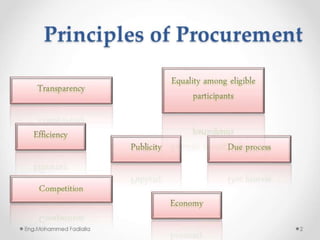

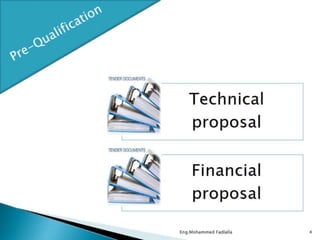
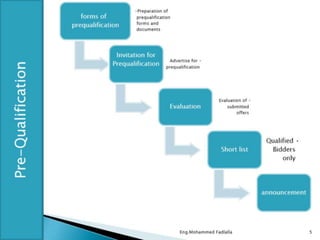
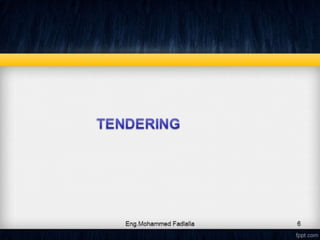

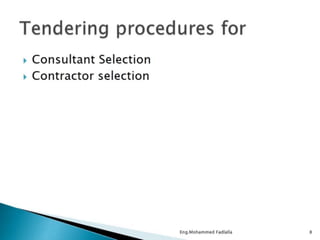

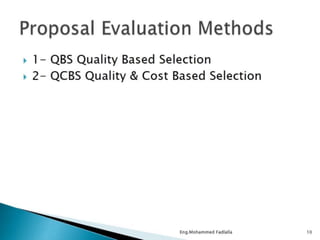
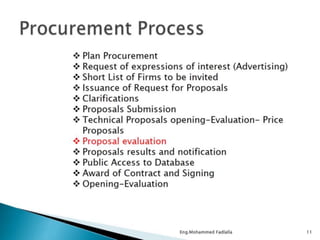
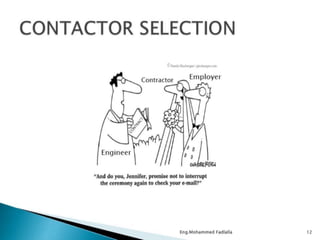
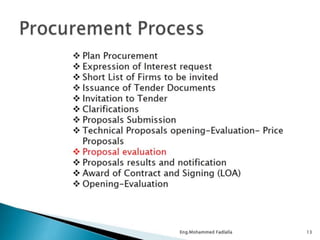
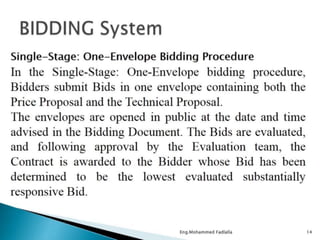

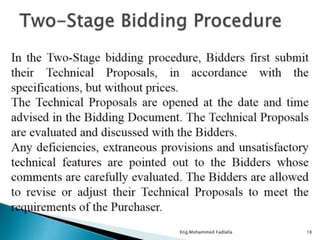

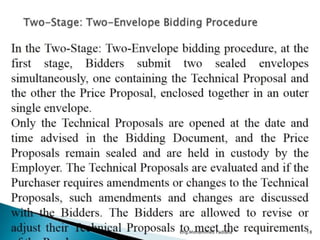
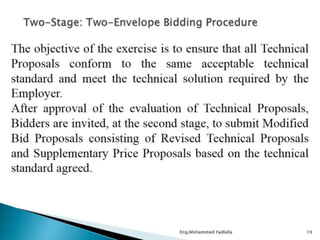
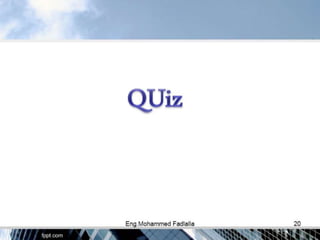




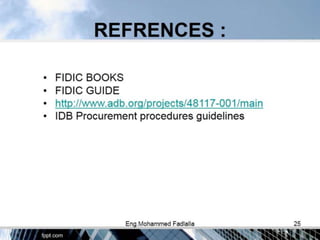
Ad
Recommended
Civil tenders and contracts spce
Civil tenders and contracts spceirkportal
╠²
The document discusses various aspects of civil tenders and contracts processes in the Indian Railways. It defines civil tenders as the process where governments and institutions invite bids for project execution within a deadline. It notes that a contract is a defined legal agreement between the tendering authority and successful bidder. It also describes the different types of tenders like open, limited, special limited, and single tenders. Additionally, it provides details on tendering processes like notice inviting tenders, publication of tenders, tender committee formation, and earnest money deposits.Estimation and Costing - Contracts
Estimation and Costing - Contractssrinivas2036
╠²
The document discusses various types of construction contracts and tendering processes. It defines a tender as an invitation from an owner to contractors to execute work at a specified cost and time. There are different types of tenders including open, sealed, limited, and single tenders. Key aspects of the tendering process include tender forms, documents, notices, evaluation criteria, acceptance procedures, contract documents, deposits, and measurements. Different types of construction contracts are also summarized such as lump-sum, item rate, percentage rate, cost plus, and turn-key contracts.Fidic contract
Fidic contract Yash Patel
╠²
FIDIC is an international federation of consulting engineers established in 1913. It publishes standard form construction contracts known by the color of their covers, such as the Red Book. The document discusses the history and evolution of FIDIC contracts, describing various contract forms like the Red Book, Yellow Book, and Silver Book. It also discusses the roles of consulting engineers and the Consulting Engineers Association of India, the Indian affiliate of FIDIC.Construction disputes
Construction disputesgayathrysatheesan1
╠²
The document discusses the various causes and factors contributing to construction disputes, including contract issues, financial aspects, and external factors. It examines different dispute resolution methods such as adjudication, expert determination, litigation, mediation, and arbitration, highlighting their advantages and disadvantages. Additionally, it emphasizes the importance of building information modeling (BIM) in preventing disputes and maintaining project efficiency.Construction contracts docuements_08092008
Construction contracts docuements_08092008AYM1979
╠²
This document provides an overview of construction contracting methods and contract types. It discusses the traditional Design-Bid-Build approach, as well as Design-Build, Turnkey, and Construction Management delivery methods. The major contract types covered are Lump Sum, Unit Price, Cost Plus, and variations like Cost Plus Fixed Fee and Cost Plus with a Guaranteed Maximum Price. For each, the document outlines the key characteristics, advantages, and disadvantages. The course appears to cover construction documents, contracting, bidding processes, and contract conditions over multiple lectures.Conditions Of Contract
Conditions Of Contractguestdb5e498
╠²
The document is the tender and contract conditions for the construction of a building in Liwan, Dubai. It includes instructions to tenderers on submitting the tender, requirements for site visits, and clarification of contract documents. The tender must include supporting documents such as proof of a site visit and a tender bond. The employer reserves the right to accept or reject any part of the tender. The tenderer is responsible for understanding all project requirements and conditions. No changes can be made to the tender documents except for filling in blanks.Contracts - Estimation, Costing and Valuation Engineering
Contracts - Estimation, Costing and Valuation EngineeringDr N Shanmugasundaram
╠²
The document details the fundamentals of contracts in civil engineering, outlining their legal nature, validity criteria, essential components, and various types of contracts such as lump-sum and cost-plus contracts. It also discusses arbitration, its advantages and disadvantages, as well as different types of arbitration like voluntary and compulsory arbitration. Key conditions of contracts and classifications are explained, emphasizing the importance of clear documentation and procedural integrity in contract management.Analysis of rates
Analysis of ratesSimarpreet Singh
╠²
The document provides an overview of rate analysis in civil engineering, detailing the process for determining costs of various construction works, including factors such as material specifications, labor costs, and site logistics. It explains the concepts of lead and lift in terms of material transport and includes specific examples of cost calculations for different materials. The document also recommends several resources for further study on estimating and costing in civil engineering projects.Tendering
Tenderingkusha Ahmed
╠²
This document provides an overview of the tendering process and types of tenders. It discusses open tendering, selective tendering, and negotiated tendering. Open tendering allows any contractor to bid, while selective tendering pre-qualifies contractors. Negotiated tendering involves inviting a specific contractor. The document also describes tender documents, including cover letters, invitations to tender, terms and conditions, bills of quantities, drawings, specifications, and evaluation criteria.UNDERPASS DESIGN
UNDERPASS DESIGNSAMPATH SADANANDA NAYAK
╠²
This document discusses the design of an underpass. It begins with objectives such as reducing accidents and providing safe and hassle-free movement of vehicles and pedestrians. It describes the methodology, survey results of the existing junction, traffic count data, soil testing results, and design of the road, box culvert, and overbridge. It includes analysis of loads and moments on structural elements. Reinforcement details are provided. Cost estimation and conclusions that the underpass will maintain vehicle speed and reduce accidents are also summarized.Concrete Mix Design
Concrete Mix DesignGAURAV. H .TANDON
╠²
This document provides information on concrete mix design, including objectives, basic considerations, and the IS (Indian Standards) method for mix design. The objectives of mix design are to achieve the desired workability, strength, durability, and cost. Basic considerations include cost, specifications, workability, strength, durability, and aggregate grading. The IS method is then described in steps, including selecting target strength, water-cement ratio, air content, water and sand contents, cement content, and aggregate contents. An example application of the IS method is also provided.Earnest Money
Earnest MoneyDr K M SONI
╠²
Earnest money is a monetary deposit paid by bidders to show their sincerity and good faith in a project. It aims to prevent bidders from withdrawing their bids before the validity period ends. Standard earnest money amounts are 2% of the estimated project cost for works costing up to Rs. 10 crores, and 1% of estimated cost plus Rs. 20 lakhs for higher value projects. Earnest money is refunded once the contract is awarded, or forfeited if the bidder withdraws during the validity period. The document discusses earnest money definitions, forms, amounts, refund processes, and treatments under different scenarios.Special concrete
Special concreteDr V Kannan B.E., M.E., PhD
╠²
Special concrete is used when special properties are more important than normal concrete properties. It is produced using chemical and mineral admixtures added to conventional concrete mixes. There are several types of special concrete including lightweight concrete, high strength concrete, fibre reinforced concrete, ferrocement, ready mix concrete, and others. Each type has specific properties and uses in construction where standard concrete is not suitable.Extension of Time (EoT) in Construction Project presentation
Extension of Time (EoT) in Construction Project presentationAyush Joshi
╠²
The document discusses extension of time (EOT) in construction projects. It outlines factors that can cause delays and qualify for an EOT, including weather, site conditions, design issues, and delays by owners or other contractors. It also summarizes requirements for applying for and approving EOTs according to standard contract forms and Nepalese law. Contractors must apply before the deadline and prove delays were outside their control. EOT approval depends on the length of extension needed and requires investigation by the owner. Liquidated damages may be assessed for contractor delays, but contracts also provide rewards for early completion.137518876 bearing-capacity-from-spt
137518876 bearing-capacity-from-spt James Chan
╠²
This document discusses methods for determining soil bearing capacity from standard penetration test (SPT) numbers. It provides Meyerhof and Bowles equations that relate allowable soil bearing capacity (Qa) to SPT numbers (N) and footing parameters. It also gives examples of using the equations to calculate Qa for different soil and footing conditions.What is construction management & its Benefits?
What is construction management & its Benefits?maria_singh
╠²
Construction management encompasses the design and implementation of construction projects, focusing on planning, time, cost, and quality control. It involves five key phases: initiation, planning, execution, monitoring, and closure, with the aim of completing projects within budget and on schedule while managing risks and maintaining quality. Effective construction management optimizes resource use, enhances teamwork, and contributes positively to society by minimizing waste and ensuring timely project delivery.Negotiated contracts
Negotiated contractsSHUBHAM SINGH
╠²
The document outlines the concept of negotiated contracts in construction, emphasizing that they are awarded based on negotiations rather than tenders. It details different types of negotiated contracts, including cost plus percentage rate, cost plus fixed fee, cost plus fee profit sharing, and cost plus sliding fee contracts, along with their respective merits and demerits. The summary highlights the implications of each contract type on cost management and contractor efficiency.Design of flexible pavement
Design of flexible pavementBhavik A Shah
╠²
This document provides an overview of the IRC method for designing flexible pavements according to IRC: 37-2012. It discusses the key considerations and calculations involved, including design traffic, subgrade properties like CBR and resilient modulus, material properties, and traffic data collection. The goal is to design a flexible pavement for a new four-lane divided national highway using the IRC guidelines and given traffic and material property data.Price variation in works contracts
Price variation in works contractsDr K M SONI
╠²
The document discusses price variation in works contracts. Price variation accounts for increases or decreases in item costs between the tender submission date and work completion date. Only major cost components like labor, steel, cement, and fuel are considered for price variation calculations. Formulas use price indices on the last tender date and work date to calculate cost variations on components. It is important to ensure like materials from the same manufacturers and locations are used in price variation analyses. Price variation may be paid quarterly and is designed to avoid cost uncertainties for contractors during long contracts over 6 months.Structural Design of Bridges
Structural Design of BridgesAIT Solutions
╠²
The document outlines a workshop on bridge design and structural engineering led by Dr. Naveed Anwar, focusing on various aspects including design processes, classification of bridge types, and recent trends in modeling. It emphasizes the importance of structural design to ensure safety, functionality, and aesthetic considerations in bridge construction. Additionally, it discusses the government's Central Expressway project in Sri Lanka and various engineering practices related to bridge systems and components.Contract Management
Contract Management Dr K M SONI
╠²
The document discusses various aspects of contract and contract management for construction works. It covers topics such as types of contracts, tender documents, pre-bid meetings, evaluation of technical and financial bids, award of work, commencement of work, coordination issues, and determination/rescission of contracts. The key points are that contract management requires fulfilling obligations by both parties, coordination is essential for success, and timely decisions need to be taken if work is unsatisfactory or delayed.Shear, bond bearing,camber & deflection in prestressed concrete
Shear, bond bearing,camber & deflection in prestressed concreteMAHFUZUR RAHMAN
╠²
The document provides a detailed overview of prestressed concrete design, including definitions, types of shear forces, and various failure modes of prestressed beams. It also discusses the implications of bond mechanics, transfer of prestressing force, and factors influencing shear strength in prestressed concrete. Additional sections cover end zone reinforcement, camber, deflection, and methods for calculating deflection in prestressed systems.Labour Laws and Financial Aspects of Construction Project _ Unit 3 _ Construc...
Labour Laws and Financial Aspects of Construction Project _ Unit 3 _ Construc...Shrikant Kate
╠²
The document outlines essential labour laws and financial aspects of construction projects, highlighting laws such as the Workmen's Compensation Act 1923 and the Building and Other Construction Workers Act 1996. It covers the importance of these laws for worker protection, fair wages, and safety, while discussing financial management, including working capital, cash flow projections, and profit-loss statements. Additionally, it describes various sources of finance, the calculation of compensation in case of accidents, and the regulations for child labor and interstate migrant workers.Contracts
Contractsgayu pandian
╠²
The document discusses various types of construction contracts, including lump sum, item rate, labour, material, percentage rate, cost plus, and turnkey contracts. It describes key elements that should be included in a construction contract agreement, such as a description of the work, payment procedures, completion dates, signatures of parties, and references to other contract documents like drawings and specifications. Disputes are typically resolved through arbitration according to the legal requirements in the contract documents.Fidic Form of Contract.
Fidic Form of Contract.Shantanu Kumar Behera
╠²
FIDIC is an international federation of consulting engineers that publishes standard forms of contract. It was founded in 1913 and is headquartered in Geneva. Some of FIDIC's most well-known standard forms include the Red, Yellow, and Silver Books. The Red Book covers construction projects, the Yellow Book covers electrical and mechanical works, and the Silver Book covers EPC/turnkey projects. FIDIC contracts establish important procedures like priority of contract documents, the engineer's role, extensions of time, insurance requirements, and dispute resolution processes involving negotiation, mediation, and arbitration.Rigid Pavement Design Part II
Rigid Pavement Design Part IISachin Kulkarni
╠²
The document details the design considerations for rigid pavements, focusing on slab thickness and stress analysis, which includes factors such as flexural and temperature stresses. It outlines critical stress conditions, design procedures, and calculations needed for determining edge and corner stresses, as well as necessary joint types for efficient stress management. Key design principles include accommodating temperature and moisture changes and ensuring the pavement's durability against loading and fatigue.Contract and Arbitration
Contract and ArbitrationJIT KUMAR GUPTA
╠²
The document discusses various aspects of contracts and arbitration in construction, emphasizing the importance of clear agreements between owners and contractors to ensure successful project completion within specified parameters. It outlines different types of contracts based on purpose and economic conditions, detailing specific contract types like lump sum and turnkey contracts, and discusses the selection and registration processes for contractors. The document also highlights arbitration as a preferred method of dispute resolution in construction projects, outline its procedures, advantages, and the characteristics of a good arbitration award.Estimating and-costing
Estimating and-costingAishwarya Deopujari
╠²
This document provides an introduction to the subject of estimating and costing for the 2nd year intermediate vocational course in construction technology. It discusses key definitions like estimating, costing, and procedures for estimating. The importance of estimation and costing is explained. The data required for preparing an estimate like drawings, specifications, and rates is described. The document also discusses complete estimates, lump sum items, and work charged establishment. Measurement units for different construction items like earthwork, concrete, masonry, woodwork, and finishing works are listed with the applicable unit of measurement and payment.Tender Process | A Complete Procurement Guide
Tender Process | A Complete Procurement GuideTender Process
╠²
The document provides a comprehensive overview of the tendering process used by governments and private sector organizations to invite and evaluate bids for projects and contracts. It details the steps involved in the tender process, the importance of compliance and value for money, and the differences between public and private sector tendering practices. Additionally, it emphasizes the need for businesses to understand their capabilities and effectively communicate their value propositions in order to succeed in competitive bidding.Tender procedure slide
Tender procedure slidepoliteknik malaysia
╠²
The document discusses the tender process for construction projects. It involves project definition, selecting tenderers, issuing tender documentation, criteria for selection, calling for tenders, tender meetings, amendments, submission and closing, tender analysis of work experience, price, company finances and personnel, ongoing projects, and conformity to conditions. Selection criteria include conformity, capability, innovation, price and construction period. Tenders can be rejected for noncompliance, incomplete details, too high or low prices, too much work in progress, insufficient finances, or unsatisfactory records.More Related Content
What's hot (20)
Tendering
Tenderingkusha Ahmed
╠²
This document provides an overview of the tendering process and types of tenders. It discusses open tendering, selective tendering, and negotiated tendering. Open tendering allows any contractor to bid, while selective tendering pre-qualifies contractors. Negotiated tendering involves inviting a specific contractor. The document also describes tender documents, including cover letters, invitations to tender, terms and conditions, bills of quantities, drawings, specifications, and evaluation criteria.UNDERPASS DESIGN
UNDERPASS DESIGNSAMPATH SADANANDA NAYAK
╠²
This document discusses the design of an underpass. It begins with objectives such as reducing accidents and providing safe and hassle-free movement of vehicles and pedestrians. It describes the methodology, survey results of the existing junction, traffic count data, soil testing results, and design of the road, box culvert, and overbridge. It includes analysis of loads and moments on structural elements. Reinforcement details are provided. Cost estimation and conclusions that the underpass will maintain vehicle speed and reduce accidents are also summarized.Concrete Mix Design
Concrete Mix DesignGAURAV. H .TANDON
╠²
This document provides information on concrete mix design, including objectives, basic considerations, and the IS (Indian Standards) method for mix design. The objectives of mix design are to achieve the desired workability, strength, durability, and cost. Basic considerations include cost, specifications, workability, strength, durability, and aggregate grading. The IS method is then described in steps, including selecting target strength, water-cement ratio, air content, water and sand contents, cement content, and aggregate contents. An example application of the IS method is also provided.Earnest Money
Earnest MoneyDr K M SONI
╠²
Earnest money is a monetary deposit paid by bidders to show their sincerity and good faith in a project. It aims to prevent bidders from withdrawing their bids before the validity period ends. Standard earnest money amounts are 2% of the estimated project cost for works costing up to Rs. 10 crores, and 1% of estimated cost plus Rs. 20 lakhs for higher value projects. Earnest money is refunded once the contract is awarded, or forfeited if the bidder withdraws during the validity period. The document discusses earnest money definitions, forms, amounts, refund processes, and treatments under different scenarios.Special concrete
Special concreteDr V Kannan B.E., M.E., PhD
╠²
Special concrete is used when special properties are more important than normal concrete properties. It is produced using chemical and mineral admixtures added to conventional concrete mixes. There are several types of special concrete including lightweight concrete, high strength concrete, fibre reinforced concrete, ferrocement, ready mix concrete, and others. Each type has specific properties and uses in construction where standard concrete is not suitable.Extension of Time (EoT) in Construction Project presentation
Extension of Time (EoT) in Construction Project presentationAyush Joshi
╠²
The document discusses extension of time (EOT) in construction projects. It outlines factors that can cause delays and qualify for an EOT, including weather, site conditions, design issues, and delays by owners or other contractors. It also summarizes requirements for applying for and approving EOTs according to standard contract forms and Nepalese law. Contractors must apply before the deadline and prove delays were outside their control. EOT approval depends on the length of extension needed and requires investigation by the owner. Liquidated damages may be assessed for contractor delays, but contracts also provide rewards for early completion.137518876 bearing-capacity-from-spt
137518876 bearing-capacity-from-spt James Chan
╠²
This document discusses methods for determining soil bearing capacity from standard penetration test (SPT) numbers. It provides Meyerhof and Bowles equations that relate allowable soil bearing capacity (Qa) to SPT numbers (N) and footing parameters. It also gives examples of using the equations to calculate Qa for different soil and footing conditions.What is construction management & its Benefits?
What is construction management & its Benefits?maria_singh
╠²
Construction management encompasses the design and implementation of construction projects, focusing on planning, time, cost, and quality control. It involves five key phases: initiation, planning, execution, monitoring, and closure, with the aim of completing projects within budget and on schedule while managing risks and maintaining quality. Effective construction management optimizes resource use, enhances teamwork, and contributes positively to society by minimizing waste and ensuring timely project delivery.Negotiated contracts
Negotiated contractsSHUBHAM SINGH
╠²
The document outlines the concept of negotiated contracts in construction, emphasizing that they are awarded based on negotiations rather than tenders. It details different types of negotiated contracts, including cost plus percentage rate, cost plus fixed fee, cost plus fee profit sharing, and cost plus sliding fee contracts, along with their respective merits and demerits. The summary highlights the implications of each contract type on cost management and contractor efficiency.Design of flexible pavement
Design of flexible pavementBhavik A Shah
╠²
This document provides an overview of the IRC method for designing flexible pavements according to IRC: 37-2012. It discusses the key considerations and calculations involved, including design traffic, subgrade properties like CBR and resilient modulus, material properties, and traffic data collection. The goal is to design a flexible pavement for a new four-lane divided national highway using the IRC guidelines and given traffic and material property data.Price variation in works contracts
Price variation in works contractsDr K M SONI
╠²
The document discusses price variation in works contracts. Price variation accounts for increases or decreases in item costs between the tender submission date and work completion date. Only major cost components like labor, steel, cement, and fuel are considered for price variation calculations. Formulas use price indices on the last tender date and work date to calculate cost variations on components. It is important to ensure like materials from the same manufacturers and locations are used in price variation analyses. Price variation may be paid quarterly and is designed to avoid cost uncertainties for contractors during long contracts over 6 months.Structural Design of Bridges
Structural Design of BridgesAIT Solutions
╠²
The document outlines a workshop on bridge design and structural engineering led by Dr. Naveed Anwar, focusing on various aspects including design processes, classification of bridge types, and recent trends in modeling. It emphasizes the importance of structural design to ensure safety, functionality, and aesthetic considerations in bridge construction. Additionally, it discusses the government's Central Expressway project in Sri Lanka and various engineering practices related to bridge systems and components.Contract Management
Contract Management Dr K M SONI
╠²
The document discusses various aspects of contract and contract management for construction works. It covers topics such as types of contracts, tender documents, pre-bid meetings, evaluation of technical and financial bids, award of work, commencement of work, coordination issues, and determination/rescission of contracts. The key points are that contract management requires fulfilling obligations by both parties, coordination is essential for success, and timely decisions need to be taken if work is unsatisfactory or delayed.Shear, bond bearing,camber & deflection in prestressed concrete
Shear, bond bearing,camber & deflection in prestressed concreteMAHFUZUR RAHMAN
╠²
The document provides a detailed overview of prestressed concrete design, including definitions, types of shear forces, and various failure modes of prestressed beams. It also discusses the implications of bond mechanics, transfer of prestressing force, and factors influencing shear strength in prestressed concrete. Additional sections cover end zone reinforcement, camber, deflection, and methods for calculating deflection in prestressed systems.Labour Laws and Financial Aspects of Construction Project _ Unit 3 _ Construc...
Labour Laws and Financial Aspects of Construction Project _ Unit 3 _ Construc...Shrikant Kate
╠²
The document outlines essential labour laws and financial aspects of construction projects, highlighting laws such as the Workmen's Compensation Act 1923 and the Building and Other Construction Workers Act 1996. It covers the importance of these laws for worker protection, fair wages, and safety, while discussing financial management, including working capital, cash flow projections, and profit-loss statements. Additionally, it describes various sources of finance, the calculation of compensation in case of accidents, and the regulations for child labor and interstate migrant workers.Contracts
Contractsgayu pandian
╠²
The document discusses various types of construction contracts, including lump sum, item rate, labour, material, percentage rate, cost plus, and turnkey contracts. It describes key elements that should be included in a construction contract agreement, such as a description of the work, payment procedures, completion dates, signatures of parties, and references to other contract documents like drawings and specifications. Disputes are typically resolved through arbitration according to the legal requirements in the contract documents.Fidic Form of Contract.
Fidic Form of Contract.Shantanu Kumar Behera
╠²
FIDIC is an international federation of consulting engineers that publishes standard forms of contract. It was founded in 1913 and is headquartered in Geneva. Some of FIDIC's most well-known standard forms include the Red, Yellow, and Silver Books. The Red Book covers construction projects, the Yellow Book covers electrical and mechanical works, and the Silver Book covers EPC/turnkey projects. FIDIC contracts establish important procedures like priority of contract documents, the engineer's role, extensions of time, insurance requirements, and dispute resolution processes involving negotiation, mediation, and arbitration.Rigid Pavement Design Part II
Rigid Pavement Design Part IISachin Kulkarni
╠²
The document details the design considerations for rigid pavements, focusing on slab thickness and stress analysis, which includes factors such as flexural and temperature stresses. It outlines critical stress conditions, design procedures, and calculations needed for determining edge and corner stresses, as well as necessary joint types for efficient stress management. Key design principles include accommodating temperature and moisture changes and ensuring the pavement's durability against loading and fatigue.Contract and Arbitration
Contract and ArbitrationJIT KUMAR GUPTA
╠²
The document discusses various aspects of contracts and arbitration in construction, emphasizing the importance of clear agreements between owners and contractors to ensure successful project completion within specified parameters. It outlines different types of contracts based on purpose and economic conditions, detailing specific contract types like lump sum and turnkey contracts, and discusses the selection and registration processes for contractors. The document also highlights arbitration as a preferred method of dispute resolution in construction projects, outline its procedures, advantages, and the characteristics of a good arbitration award.Estimating and-costing
Estimating and-costingAishwarya Deopujari
╠²
This document provides an introduction to the subject of estimating and costing for the 2nd year intermediate vocational course in construction technology. It discusses key definitions like estimating, costing, and procedures for estimating. The importance of estimation and costing is explained. The data required for preparing an estimate like drawings, specifications, and rates is described. The document also discusses complete estimates, lump sum items, and work charged establishment. Measurement units for different construction items like earthwork, concrete, masonry, woodwork, and finishing works are listed with the applicable unit of measurement and payment.Viewers also liked (20)
Tender Process | A Complete Procurement Guide
Tender Process | A Complete Procurement GuideTender Process
╠²
The document provides a comprehensive overview of the tendering process used by governments and private sector organizations to invite and evaluate bids for projects and contracts. It details the steps involved in the tender process, the importance of compliance and value for money, and the differences between public and private sector tendering practices. Additionally, it emphasizes the need for businesses to understand their capabilities and effectively communicate their value propositions in order to succeed in competitive bidding.Tender procedure slide
Tender procedure slidepoliteknik malaysia
╠²
The document discusses the tender process for construction projects. It involves project definition, selecting tenderers, issuing tender documentation, criteria for selection, calling for tenders, tender meetings, amendments, submission and closing, tender analysis of work experience, price, company finances and personnel, ongoing projects, and conformity to conditions. Selection criteria include conformity, capability, innovation, price and construction period. Tenders can be rejected for noncompliance, incomplete details, too high or low prices, too much work in progress, insufficient finances, or unsatisfactory records.The Basics of
Tendering & Bidding
The Basics of
Tendering & BiddingMoatasem Mabrouk
╠²
The document provides an overview of the tendering and bidding process. It defines key terms like tender, bid, proposal, and procurement methods. The tender process involves several steps - pre-tender activities, issuing the tender, tender evaluation, and awarding the contract. The bidding process map outlines various stages from announcement to awarding. The evaluation process consists of opening bids, examining them, requesting clarifications, evaluating and comparing bids, post-qualification, and recommending a winner. Key points of evaluation include checking for completeness, computational errors, and applying criteria to determine the lowest bidder.Tendering in construction introduction
Tendering in construction introductionDaniel Ross
╠²
The document discusses tendering processes for construction projects. It defines tendering as sending drawings and bills of quantities to contractors to receive price estimates. The purpose of tendering is to select a main contractor. Different procurement methods are described such as traditional where the client separately selects a designer and contractor, or design-build where one company handles both. Factors like project size and economic climate affect the tendering method choice. Students are tasked to discuss tendering purposes and objectives, and select a method for a given project by considering build type.Tender processing
Tender processingdnyandev_d
╠²
The document provides guidelines for entering tender notices into a database. It describes the important fields that should be included such as organization name and address, project details, estimated costs, bid bonds, tender values, deadlines, and notice types. Fields should be accurately completed and formatting checked. International and national tenders should be distinguished. Only tenders with sufficient deadline periods should be entered.Tender evaluation procedure
Tender evaluation procedureayushida
╠²
This document outlines information regarding a course on tender evaluation processes. It discusses the course objectives, which are to understand the tender evaluation process and criteria. It describes the typical evaluation process, which involves 6 stages from issuing the tender to acceptance of bids. It also outlines the criteria used, which differ based on project size. The document provides details on the typical information and documents required for bid submissions and evaluates the bidder. It describes the multi-stage evaluation process used to assess bids for compliance, completeness, financial capacity, and experience.Recent Trends and Legal Developments You Should Consider in 2015: Part I ŌĆō Me...
Recent Trends and Legal Developments You Should Consider in 2015: Part I ŌĆō Me...Winston & Strawn LLP
╠²
The document presents recent trends and legal developments in mergers and acquisitions (M&A) as of 2015, highlighting a significant increase in global deal volume in 2014, which reached $3.5 trillion. It discusses corporate inversion transactions, detailing the impact of U.S. tax rules on foreign mergers, and mentions new anti-inversion regulations introduced to mitigate tax avoidance strategies. Key insights include the rise in mega-deals and shifts in transaction structures, particularly in the context of U.S. companies engaging in cross-border M&A activities.Adb procurement guidelines introduction2
Adb procurement guidelines introduction2Joy Irman
╠²
This document summarizes key points from the Asian Development Bank Procurement Guidelines regarding joint ventures, ADB review of procurement processes, misprocurement, references to ADB in contracts, and fraud and corruption. It discusses that firms can bid independently or in joint ventures, ADB reviews procurement to ensure compliance, misprocurement may result in canceled financing, contracts must reference ADB as the source of funding, and ADB has a zero tolerance policy for corrupt practices. It also provides that borrowers must prepare and obtain ADB approval of an initial 18-month procurement plan.PPPFA forum
PPPFA forumLeila Moonda
╠²
The document discusses regulations regarding preferential procurement in South Africa, specifically:
1) New regulations were approved in June 2011 to align the Preferential Procurement Policy Framework Act (PPPFA) and Broad-Based Black Economic Empowerment (BBBEE) Act, which will have wide-reaching implications.
2) The PPPFA takes effect in December 2011 and changes the point system to incorporate BBBEE compliance, using 80/20 and 90/10 preference point systems for procurement above certain thresholds.
3) The regulations provide guidance on evaluating bids, awarding contracts, subcontracting requirements, and establishing BEE strategies and preferential procurement processes.Bangladesh
BangladeshMerve Ûzdemir
╠²
Bangladesh is a South Asian country located between India and Myanmar. It has a population of over 148 million and Dhaka is its capital city. The national language is Bengali and over 90% of the population is Muslim. Key cultural aspects include clothing like saris and shalwar kameez, foods such as biryani and panta ilish, and festivals like Eid ul-Fitr and Pohela Boishakh. The national animal is the Royal Bengal Tiger and national bird is the doel.How to Tender for Public Sector Contracts
How to Tender for Public Sector ContractsTheClonmelChamber
╠²
The document provides guidance on how to successfully submit tenders for public sector contracts. It outlines the key steps including understanding the tender requirements, preparing supporting company documents, adhering to submission formats and deadlines, and evaluating feedback to improve future submissions. Regularly assessing performance and learning from experience are emphasized as important parts of the continuous tendering process.Intro To Procurement And Tendering In Wales ║▌║▌▀Żset
Intro To Procurement And Tendering In Wales ║▌║▌▀ŻsetDawn_Rowley
╠²
This document provides an introduction to procurement and tendering processes in the public sector in Wales. It aims to increase understanding of the rules and processes behind public sector tendering. The objectives are to set tendering in its proper context and improve organizations' ability to identify, prepare for and respond successfully to tender opportunities. It covers the context of EU and UK public sector tendering, definitions, the tendering process, who it applies to and what types of goods and services it covers. It also discusses the changing political landscape in Wales and support available for the voluntary sector.UDL as an Architecture for Learning
UDL as an Architecture for Learningitslearning, inc.
╠²
The document discusses Universal Design for Learning (UDL) principles aimed at improving accessibility in educational environments, emphasizing the importance of removing barriers for diverse learners. Key concepts include providing multiple means of engagement, representation, and action/expression for students. It also highlights various resources and technologies to support UDL implementation in K-12 education.Design of two stage OP AMPazmathmoosa
╠²
Le document traite des caract├®ristiques des circuits ├®lectroniques, notamment d'un amplificateur avec plusieurs ├®tapes. Il aborde les param├©tres fondamentaux tels que le temps de settling, la tension de sortie et les mod├©les math├®matiques associ├®s aux transistors. Les relations entre les diff├®rents composants et leurs comportements ├®lectriques sont ├®galement discut├®es.Tendering Document for the Procurement of Works
Tendering Document for the Procurement of WorksMohammad Alimuzzaman Bappy
╠²
This document outlines the tendering process for a construction project. It includes sections on instruction to tenderers, qualification criteria, tender preparation and submission, tender opening and evaluation, and contract award. It provides details on project scope, eligibility, language and currency, submission deadlines, performance security requirements, and dispute resolution procedures. The bill of quantities specifies items for earthworks, concrete works, reinforcement, masonry, finishes, and facilities. Specifications cover materials, workmanship, and testing. Drawings include floor plans, sections, schedules and reinforcement details.Ethiopian tender practice
Ethiopian tender practiceEyob Ahmed
╠²
The document summarizes existing tender practices in Ethiopia. It discusses the different types of tenders used - open tendering, two-stage tendering, and restricted tendering. For each type, it outlines the key steps that must be followed in the tendering process according to Ethiopia's procurement manual, including preparing bidding documents, evaluating bids, and selecting suppliers. The purpose of having standardized tender practices is to simplify the process for procuring entities and bidders, and help ensure public funds are used appropriately.01 bidding document uitrce final draft
01 bidding document uitrce final draftSangHoon Yeo
╠²
This document is a bidding document from the Bangladesh Bureau of Educational Information and Statistics (BANBEIS) for the procurement of establishing Upazila ICT Training and Resource Centres for Education (UITRCE) in selected 128 upazilas in Bangladesh. Key details include:
- BANBEIS is inviting sealed bids from eligible bidders to establish the UITRCE centres, which will include constructing two-storied buildings with foundations for four stories and supplying, installing, and testing ICT and other equipment.
- The project is funded by a loan from the Export-Import Bank of Korea from the resources of the Economic Development Cooperation Fund of the Republic of Korea totaling 39Lec 4-analyzing-supply-market
Lec 4-analyzing-supply-marketZahidul Eshrak
╠²
The document discusses analyzing a supply market. It provides an overview of the supply market analysis process which involves several steps: 1) assessing the ability of different markets to meet requirements, 2) identifying markets with the best opportunities and lowest risk, 3) understanding factors that influence the market. The analysis also considers segmenting the supply market based on geographic location, technology, or supply channel to better understand risks and opportunities. Monitoring market risks and opportunities is important to keep supply targets and options up to date.1713865
1713865Veluppillai Mohan
╠²
This document provides a standard bidding document template for the procurement of goods up to Nu. 0.25 million through national competitive bidding in Bhutan. It includes sections for the request for quotation, invitation for quotation, schedule of items and priced quotation bid form, technical specifications, required documents for submission, terms and conditions, purchase order, contract agreement, and performance security. The template is to be used in conjunction with procurement rules and regulations and provides guidance for the procurement process and contents required for bidding.Re Defining The Learning Architecture In Your School Tony Carrucan
Re Defining The Learning Architecture In Your School Tony Carrucantcarrucan
╠²
Mediasphere is an Australian e-learning company specializing in web-based platforms, digital content, and mobile app development, receiving multiple awards for excellence in education between 2003 and 2011. The company advocates for a shift in educational practices to incorporate cloud computing, flexible learning spaces, and 21st-century skills, aiming to enhance learning environments and prepare students for the workforce. Mediasphere offers various tools and resources to create connected school communities and improve teaching outcomes through innovative ICT strategies.Recent Trends and Legal Developments You Should Consider in 2015: Part I ŌĆō Me...
Recent Trends and Legal Developments You Should Consider in 2015: Part I ŌĆō Me...Winston & Strawn LLP
╠²
Ad
Recently uploaded (20)
Generative AI & Scientific Research : Catalyst for Innovation, Ethics & Impact
Generative AI & Scientific Research : Catalyst for Innovation, Ethics & ImpactAlqualsaDIResearchGr
╠²
Invited keynote at the Artificial Intelligence Symposium on AI-powered Research Innovation, taking place at ENSEM (L'├ēcole Nationale Sup├®rieure d'├ēlectricit├® et de M├®canique), Casablanca on June 21, 2025. IŌĆÖll be giving a keynote titled: "Generative AI & Scientific Research: Catalyst for Innovation, Ethics & Impact". Looking forward to engaging with researchers and doctoral students on how Generative AI is reshaping the future of science, from discovery to governance ŌĆö with both opportunities and responsibilities in focus.
#AI hashtag#GenerativeAI #ScientificResearch #Innovation #Ethics #Keynote #AIinScience #GAI #ResearchInnovation #Casablanca
1. Thinking, Creative Thinking, Innovation
2. Societies Evolution from 1.0 to 5.0
3. AI - 3P Approach, Use Cases & Innovation
4. GAI & Creativity
5. TrustWorthy AI
6. Guidelines on The Responsible use of GAI In ResearchStructured Programming with C++ :: Kjell Backman
Structured Programming with C++ :: Kjell BackmanShabista Imam
╠²
Step into the world of high-performance programming with the Complete Guidance Book of C++ ProgrammingŌĆöa definitive resource for mastering one of the most powerful and versatile languages in computer science.
Whether you're a beginner looking to learn the fundamentals or an intermediate developer aiming to sharpen your skills, this book walks you through C++ from the ground up. You'll start with basics like variables, control structures, and functions, then progress to object-oriented programming (OOP), memory management, file handling, templates, and the Standard Template Library (STL).Data Structures Module 3 Binary Trees Binary Search Trees Tree Traversals AVL...
Data Structures Module 3 Binary Trees Binary Search Trees Tree Traversals AVL...resming1
╠²
This covers binary trees, binary search trees, BST insertion, deletion, tree traversals - inorder, preorder, postorder, AVL trees, AVL tree insertion, deletion, BTrees - insertion, deletion, hash tables etc.Tesla-Stock-Analysis-and-Forecast.pptx (1).pptx
Tesla-Stock-Analysis-and-Forecast.pptx (1).pptxmoonsony54
╠²
this is data science ppt for tesla stock (linear regression)Abraham Silberschatz-Operating System Concepts (9th,2012.12).pdf
Abraham Silberschatz-Operating System Concepts (9th,2012.12).pdfShabista Imam
╠²
Complete book of operating system edition 9Deep Learning for Natural Language Processing_FDP on 16 June 2025 MITS.pptx
Deep Learning for Natural Language Processing_FDP on 16 June 2025 MITS.pptxresming1
╠²
This gives an introduction to how NLP has evolved from the time of World War II till this date through the advances in approaches, architectures and word representations. From rule based approaches, it advanced to statistical approaches. from traditional machine learning algorithms it advanced to deep neural network architectures. Deep neural architectures include recurrent neural networks, long short term memory, gated recurrent units, seq2seq models, encoder decoder models, transformer architecture, upto large language models and vision language models which are multimodal in nature.MATERIAL SCIENCE LECTURE NOTES FOR DIPLOMA STUDENTS
MATERIAL SCIENCE LECTURE NOTES FOR DIPLOMA STUDENTSSAMEER VISHWAKARMA
╠²
This PPT contains notes for taking lecture at diploma level.Introduction to Natural Language Processing - Stages in NLP Pipeline, Challen...
Introduction to Natural Language Processing - Stages in NLP Pipeline, Challen...resming1
╠²
Lecture delivered in 2021. This gives an introduction to Natural Language Processing. It describes the use cases of NLP in daily life. It discusses the stages in NLP Pipeline. It highlights the challenges involved covering the different levels of ambiguity that could arise. It also gives a brief note on the present scenario with the latest language models, tools and frameworks/libraries for NLP.Microwatt: Open Tiny Core, Big Possibilities
Microwatt: Open Tiny Core, Big PossibilitiesIBM
╠²
Microwatt is a lightweight, open-source core based on the OpenPOWER ISA.
ItŌĆÖs designed for FPGAs and easy experimentation in chip design.
Ideal for education, prototyping, and custom silicon development.
Fully open, it empowers developers to learn, modify, and innovate.Proposal for folders structure division in projects.pdf
Proposal for folders structure division in projects.pdfMohamed Ahmed
╠²
Proposal for folders structure division in projectsInternational Journal of Advanced Information Technology (IJAIT)
International Journal of Advanced Information Technology (IJAIT)ijait
╠²
International journal of advanced Information technology (IJAIT) is a bi monthly open access peer-
reviewed journal, will act as a major forum for the presentation of innovative ideas, approaches,
developments, and research projects in the area advanced information technology applications and
services. It will also serve to facilitate the exchange of information between researchers and industry
professionals to discuss the latest issues and advancement in the area of advanced IT. Core areas of
advanced IT and multi-disciplinary and its applications will be covered during the conferences.Validating a Citizen Observatories enabling Platform by completing a Citizen ...
Validating a Citizen Observatories enabling Platform by completing a Citizen ...Diego L├│pez-de-Ipi├▒a Gonz├Īlez-de-Artaza
╠²
Citizen Observatories (COs) are initiatives that empower citizens to engage in data collection, analysis and interpretation in order to address various issues affecting their communities and contribute to policy-making and community development.
Thematic co-exploration is a co-production process where citizens actively participate alongside scientists and other actors in the exploration of specific themes.
Making them a reality involves addressing the following challenges:
Data quality and reliability
Engagement and retention of participants
Integration with policy and decision-making
Fatality due to Falls at Working at Height
Fatality due to Falls at Working at Heightssuserb8994f
╠²
It is related to fatality due to falls at working at heightIntroduction to Python Programming Language
Introduction to Python Programming Languagemerlinjohnsy
╠²
This PPT covers features, applications, variable, data types and statements in PythonMay 2025: Top 10 Read Articles in Data Mining & Knowledge Management Process
May 2025: Top 10 Read Articles in Data Mining & Knowledge Management ProcessIJDKP
╠²
Data mining and knowledge discovery in databases have been attracting a significant amount of research, industry, and media attention of late. There is an urgent need for a new generation of computational theories and tools to assist researchers in extracting useful information from the rapidly growing volumes of digital data.
This Journal provides a forum for researchers who address this issue and to present their work in a peer-reviewed open access forum. Authors are solicited to contribute to the Journal by submitting articles that illustrate research results, projects, surveying works and industrial experiences that describe significant advances in the following areas, but are not limited to these topics only.CST413 KTU S7 CSE Machine Learning Clustering K Means Hierarchical Agglomerat...
CST413 KTU S7 CSE Machine Learning Clustering K Means Hierarchical Agglomerat...resming1
╠²
This covers CST413 KTU S7 CSE Machine Learning Module 4 topics - Clustering, K Means clustering, Hierarchical Agglomerative clustering, Principal Component Analysis, and Expectation Maximization.Generative AI & Scientific Research : Catalyst for Innovation, Ethics & Impact
Generative AI & Scientific Research : Catalyst for Innovation, Ethics & ImpactAlqualsaDIResearchGr
╠²
Validating a Citizen Observatories enabling Platform by completing a Citizen ...
Validating a Citizen Observatories enabling Platform by completing a Citizen ...Diego L├│pez-de-Ipi├▒a Gonz├Īlez-de-Artaza
╠²
Ad
